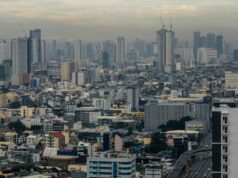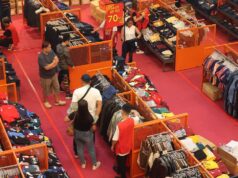Fragile kings of the Philippine road no match for coronavirus
By Arjay L. Balinbin, Reporter
DENNIS O. CLEDERA, 36, has been living in a two-decade old jeepney he used to drive since the main Philippine island of Luzon was locked down in mid-March, forcing many of his kind out of the roads and out of work.
“This is my bread and butter,” the driver, who lives in a village called Progress near Manila, the capital, said in an interview in Filipino, teary-eyed. “We’re poor and I can’t shift to becoming a construction worker because I don’t have the skills and a backer.”
 Mr. Cledera now lives off daily food rations from his operator while old jeepneys and most buses remained banned to contain a novel coronavirus pandemic that has sickened more than 30,000 and killed at least 1,169 people in the Philippines.
Mr. Cledera now lives off daily food rations from his operator while old jeepneys and most buses remained banned to contain a novel coronavirus pandemic that has sickened more than 30,000 and killed at least 1,169 people in the Philippines.
President Rodrigo R. Duterte locked down Luzon on March 17, suspending work, classes and public transportation to contain the pandemic. People should stay home except to buy food and other basic goods, he said.
The lockdown in many parts of the country including the capital region where infections are mostly concentrated has since been relaxed, but the wildly painted jeepney that has become a Philippine cultural icon remained banned.
Transportation Secretary Arthur P. Tugade on June 2 said the ban on jeepneys, where passengers closely sit next to and in front of each other, was in keeping with state efforts to “balance our responsibility to make sure the spread of the virus is contained.”
“Does it mean we won’t be using traditional jeepneys anymore? No,” he told a news briefing. He added that in the “hierarchy of transportation,” jeepneys may be allowed to operate soon as long as they’re roadworthy.
At the top of this hierarchy are high-capacity vehicles such as trains, buses and modern public utility vehicles (PUVs), Mr. Tugade said.
Under the plan, mass transport will resume in two phases. Under the first phase from June 1 to 21, trains, limited buses, taxis, ride-hailing services and shuttle services, point-to-point buses and bicycles were allowed with limited capacity.
Provincial buses are still barred from entering Manila and nearby cities. The decision to allow tricycles in many villages to move people rests on local governments.
Under the second phase from June 22 to 30, modern jeepneys, public utility buses and public vans will be allowed with a limited capacity. Transport vehicles must follow the one-meter physical distancing rule for passengers.
INADEQUATE
There’s also a plan to build dedicated lanes for bicycles, which was unheard of before the lockdown except for certain cities near Manila.
Jose Regin F. Regidor, a research fellow at the University of the Philippines National Center for Transportation Studies, said government action on public transportation had been inadequate.
“Why can’t they quickly provide safe paths when there’s a clamor for bike lanes?” he said by telephone. “The government is overanalyzing the situation. Why not allot one of the 10 lanes for bicycles since you can’t provide public transportation?”
Transport expert Rene S. Santiago said allowing buses to resume operations without jeepneys, which is the vehicle of choice of 40% of Filipino commuters, was impractical. He noted that when the government experimented with its bus augmentation project for trains, few passengers used these buses.
“Not all have access to modern vehicles such as the LRT and MRT,” Mar S. Valbuena, president of the Samahang Manibela Mananakay at Nagkaisang Terminal ng Transportasyon, said by telephone “What about the secondary roads where only jeepneys have access to? If you take out the jeepneys, where will those commuters go?”
“We are only talking about Manila where you have buses and trains,” Mr. Santiago said. He noted that Cebu in central Philippines has no rail — as much as 95% of public vehicles there are jeepneys — while buses in Davao are virtually nonexistent.
While the country’s jeepneys do pose a risk to spreading the coronavirus, “there are ways to get around it,” Mr. Santiago said.
Operators can put plastic barriers in the middle of their jeepneys and raise the roofs to increase ventilation. An electric fan in the middle could also force the wind out, he said. The government could also require jeepney passengers to wear face shields instead of just face masks.
A cashless payment system could also limit infections, he said. Mr. Santiago said banning jeepneys cripples mobility, which in turn limits economic growth.
‘FLAT BROKE’
Mr. Valbuena said the government must address the plight of the country’s half-a-million jeepney drivers, 140,000 of whom are in the capital region.
“Jeepney drivers are flat broke and living hand to mouth,” he said. “Then the lockdown happened and they were unprepared. They don’t have any savings and not all of them were given cash aid.”
Presidential spokesman Harry L. Roque, Jr. earlier said the government was seeking to repurpose idle jeepneys into delivery vehicles. He also said jobless jeepney drivers would get cash aid again under the second tranche of the program.
There is also a plan for the government to hire transport operators to serve some areas during the lockdown.
“That is a disaster in the making,” Mr. Santiago said, adding that it could lead to favoritism. A better solution is to allow all modes of public transportation to operate again, he added.
If this happens, jeepneys and buses could lose a lot because only half their capacity will be filled. The Land Transportation Franchising and Regulatory Board has also ruled out fare increases.
“If they don’t want to increase the fares by 25% or 30%, they can subsidize the riders,” Mr. Santiago said. “Give them an e-card with a loaded amount for their trips. But you have to subsidize not just jeepneys but all modes including air and water transport. That’s the tricky part,” he added.
On June 2, police arrested six jeepney drivers in Caloocan City after they protested their continued ban under a relaxed lockdown. One of them was a 72-year-old man named Elmer Cordero. The Commission on Human Rights has expressed “deep concern” about the arrests.
“They were seeking government support and they got arrested instead. There’s something wrong with that,” Mr. Valbuena said.
He said the government might be using the pandemic to push its agenda of phasing out old jeepneys. The regulator has said the deadline for the modernization for jeepneys would proceed by the end of the month.
Under the modernization program launched in June 2017, operators must stop using 15-year-old units and older, and replace these with new ones in three years.
To date, only 4% of about 370,000 old jeepneys nationwide have been replaced, Mr. Valbuena said.
More than 300 modern jeepneys were allowed this week to serve 15 routes in Manila and nearby cities.
“If only modern jeepneys are allowed, where will the commuters go? And what will happen to displaced jeepney drivers?” Mr. Valbuena said.
Mr. Regidor, the academician, said this might not be the right time to push the modernization program.
“We need to think about the demand for transportation now,” he said. “Vulnerable people will suffer. Jeepney drivers have been jobless for the past three months and then you will threaten them with a phase-out?”
Mr. Cledera, the jeepney driver mentioned at the outset, got an P8,000 cash aid from the Social Welfare department in April that he sent to his family in Bicol right away. “I’m penniless and I still have a four-year-old child to feed.”



